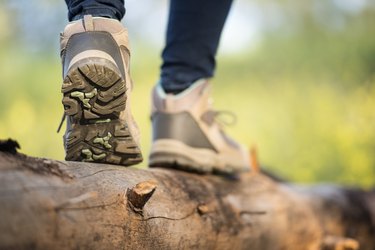
Walking is the perfect exercise for many of us: gentle, low impact and accessible. The Cleveland Clinic notes that walking benefits you in many ways, such as helping to lower bad cholesterol and raise the good kind, as well as managing stress, weight, mood, blood sugar levels and blood pressure.
However, the common problem of blisters on your feet is frustrating and painful enough to sideline anyone's fitness regimen. Exercise walkers should be careful to avoid blisters and know how to properly treat them if they appear.
Video of the Day
Video of the Day
Tip
Blisters often develop on your feet due to friction from footwear or socks, but can also occur after trauma.
Blister on Bottom of Heel
Harvard Health Publishing points out that friction blisters appear when improperly fitting shoes or clothing rub against the skin. Over time, this friction causes the outer layer of skin to separate from the inner layers, forming a pocket between the layers. Sensing irritation, the body responds by creating lymph fluid to lubricate the area.
The pocket fills with this lymph fluid and creates the familiar bubble known as a blister. This type of blister is generally a reaction to ill-fitting shoes, improper shoes with large interior seams and perspiration. Blisters on the bottom of the heel are likely to be caused by the foot sliding back and forth in a too-large shoe in combination with the warm, wet conditions caused by perspiration.
Read more: How to Run With a Blister
Causes of Blood Blisters
Blood blisters are similar in action and appearance to common blisters, but are red in color due to blood that has leaked into the lymph and tissues in response to strain or trauma. This type of blister indicates that a blood vessel has been damaged or broken by an impact or pinch, possibly in addition to the creation of a common blister.
Blood blisters are not dangerous, but they are a sign that a larger degree of irritation may be present. A blood blister on the bottom of the foot is probably a sign of a sudden impact.
Tips for Preventing Blisters
The common blister is relatively easy to avoid. Make sure your walking shoes fit properly, since both too-tight and too-loose shoes may lead to excessive friction. Choose shoes that fit without creating pressure against the anklebones or heel and socks that are close-fitting and not too thick. Change your socks often and use foot powder to keep the foot dry.
Check the insides of your shoes for any raised seams. If you find any potential sources of irritation, select a different pair of shoes. If new shoes are not an option, or you continue to get blisters in spite of preventative methods, you may use athletic tape or petroleum jelly on the blister-prone areas prior to walking.
Read more: The Best Reviewed Walking Shoes for Seniors
Treatment for Blisters
Most blisters will drain and go away on their own, although in some cases they might need to be drained. It is safest to have this performed in a doctor's office — contaminating your blister can lead to infection. However, according to Mayo Clinic, the blister can be punctured in several places around the edge with a sterile needle, leaving the skin intact.
After the fluid drains, gently apply antibiotic cream or ointment to the area, and cover it with a sterile bandage. If you will be walking again before the wound heals, use athletic tape to secure the bandage.
- SportsInjuryClinic.net: "Feet Blisters: Treatment and Prevention"
- Mayo Clinic: "Blisters: First Aid"
- Army Public Health Center: "Blister Prevention"
- Cleveland Clinic: "Walking Your Way to Better Health"
- Harvard Health Publishing: "Friction Blisters"
- Sportsinjuryclinic.net: Taping (Blister Prevention)